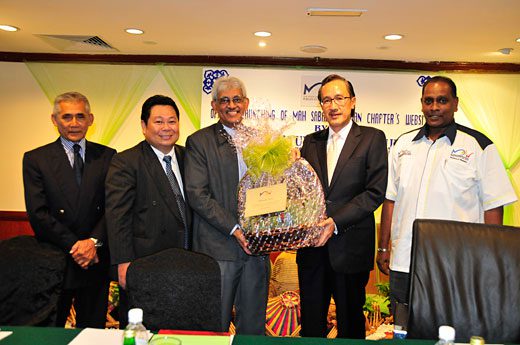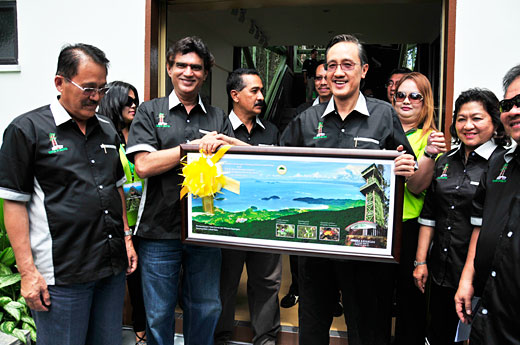Sabah’s own upside down house, said to be the first in South East Asia, has received encouraging support from the public, according to its proud owner Alexander Yee. He said since it was opened to visitors about a month ago, there has been an endless flow of curious souls who came from near and far to see the ‘bizarre’ building with their own eyes.
Encouraged by the positive response, Yee said he was eager to further develop his creation into something bigger.
“I hope Rumah Terbalik in future will become more than just a stop over destination for visitors. I am looking forward to see it become a must-see tourist attraction for Sabah,” he said during the official launching of the property Friday evening.
Yee also announced that the Upside Down House of Borneo, located at Mile 21, Jalan Telibong, has been officially included in the Malaysia Guinness Book of Records.
Building a topsy-turvy house is not a new idea but unconventional structures like this is still considered rare, with only a few renowned ones in the world.
This idea of “house flipping” has created a buzz in recent years with the emergence of a number of interestingly freaky upside down buildings in many countries across the globe.
Among the better known are the upside down restaurant in Matsumoto city, Nagano prefecture, Japan; the Upside Down Church and the WonderWork Amusement Park in the United State; Die Welt Steht Kopf (“The World Stands on its Head”) House on the island of Usedom in the Baltic Sea, The House-Attack in Vienna, Austria; and The House of Katmandu on the Spanish island of Majorca.
The idea seemed to catch up, with more and more individuals and companies trying to design their own bizarre most original upside down houses, theme parks, museums, restaurants and so on.
Wherever they pop up, it is almost certain that they will become a tourist hit. And why not, stepping onto such a rare structure that allows visitors experience the world from a new, upside down perspective is fun.
Like most of its predecessors, the Upside Down House of Borneo was built with its own philosophy, to communicate a message to those who cared to lay their eyes on it.
“Continuing unchecked development will affect the environment, the livelihood of the people. It’s like turning the world upside down. This house was built based on this philosophy,” said Yee, who is an eager environmentalist.
Minister of Tourism, Culture and Environment Datuk Masidi Manjun who officiated at the launching, said Sabah has reached a level where creativity has to be the cornerstone of its tourism sector.
The ‘Rumah Terbalik’, he added, was a good example of how the State’s tourism industry should move forward.
“We need to create many, many new products. Yes, the nature is there but we need to have more varieties,” he said.
Source: Borneo Post (by Murib Morpi)
 YB Datuk Masidi Manjun launched the Malaysian Hotel Association (Sabah/Labuan) website on the 20th March 2012 at Sutera Harbour Resort.
YB Datuk Masidi Manjun telah melancarkan laman sesawang Persatuan Hotel Malaysia (Sabah/Labuan) pada 20 Mac 2012 bertempat di Sutera Harbour Resort.
YB Datuk Masidi Manjun launched the Malaysian Hotel Association (Sabah/Labuan) website on the 20th March 2012 at Sutera Harbour Resort.
YB Datuk Masidi Manjun telah melancarkan laman sesawang Persatuan Hotel Malaysia (Sabah/Labuan) pada 20 Mac 2012 bertempat di Sutera Harbour Resort.


 YB Datuk Masidi Manjun on behalf of the Chief Minister of Sabah during the Lahad Datu Tower of Heaven, Mount Silam Official Launching in Lahad Datu on the 19th of March 2012. Seen in the picture, YB Datuk Masidi Manjun receiving a souvenir from YBhg Datuk Sam Mannan, Director of Sabah Forestry Department.
YB Datuk Masidi Manjun mewakili Ketua Menteri Sabah dalam Majlis Perasmian Menara Kayangan Lahad Datu, Gunung Silam bertempat di Lahad Datu pada 19 Mac 2012. Kelihatan dalam gambar, YB Datuk Masidi Manjun menerima cendera kenangan daripada YBhg Datuk Sam Mannan, Pengarah Perhutanan Negeri Sabah.
YB Datuk Masidi Manjun on behalf of the Chief Minister of Sabah during the Lahad Datu Tower of Heaven, Mount Silam Official Launching in Lahad Datu on the 19th of March 2012. Seen in the picture, YB Datuk Masidi Manjun receiving a souvenir from YBhg Datuk Sam Mannan, Director of Sabah Forestry Department.
YB Datuk Masidi Manjun mewakili Ketua Menteri Sabah dalam Majlis Perasmian Menara Kayangan Lahad Datu, Gunung Silam bertempat di Lahad Datu pada 19 Mac 2012. Kelihatan dalam gambar, YB Datuk Masidi Manjun menerima cendera kenangan daripada YBhg Datuk Sam Mannan, Pengarah Perhutanan Negeri Sabah.
